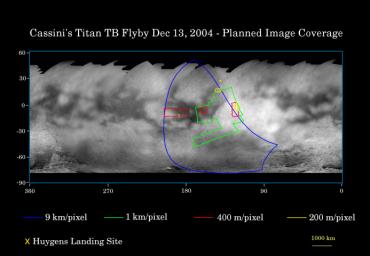This map of Titan's surface illustrates the regions that will be imaged by the Cassini spacecraft during the spacecraft's second close flyby of Titan on Dec. 13, 2004.
The colored lines delineate the regions that will be imaged at differing resolutions. The lower-resolution imaging sequences (outlined in blue) are designed to study the atmosphere, clouds, and surface in a variety of spectral filters, and to make movies of the evolution of clouds over time scales of hours. Other areas have been specifically targeted for moderate and high resolution mosaicking of surface features. These include the site where the European Space Agency's Huygens probe is predicted to touch down in mid-January (marked with the yellow X), part of the bright region named Xanadu (easternmost extent of the coverage area), and a boundary between dark and bright regions. The map shows only brightness variations on Titan's surface. (The illumination is such that there is no shading due to topographic variations). Previous observations indicate that due to Titan's thick, hazy atmosphere, the sizes of surface features that can be resolved are a few to five times the actual pixel scale labeled on the map.
The December encounter is similar in geometry to the first close Titan flyby in October (see PIA06116), so Cassini scientists have taken advantage of this to retarget some of the same areas in order to look for changes and to cover new territory as well. This is the reason for the rather irregular shape of the green outline.
The map was made from global images taken in June 2004 at image scales of 35 to 88 kilometers (22 to 55 miles) per pixel and from south polar coverage from July 2004 at an image scale of 2 kilometers (1.3 miles) per pixel. The images were obtained using a narrow band filter centered at 938 nanometers - a near-infrared wavelength (invisible to the human eye) that can penetrate Titan's atmosphere to the surface. The images have been processed to enhance surface details.
It is currently northern winter on Titan, so Titan's high northern latitudes are not illuminated, resulting in the jagged upper boundary. Clouds near the south pole (see PIA06110) have also been removed (south of minus 75 degrees).
The Cassini-Huygens mission is a cooperative project of NASA, the European Space Agency and the Italian Space Agency. The Jet Propulsion Laboratory, a division of the California Institute of Technology in Pasadena, manages the Cassini-Huygens mission for NASA's Office of Space Science, Washington, D.C. The Cassini orbiter and its two onboard cameras, were designed, developed and assembled at JPL. The imaging team is based at the Space Science Institute, Boulder, Colo.
For more information, about the Cassini-Huygens mission visit, http://saturn.jpl.nasa.gov and the Cassini imaging team home page, http://ciclops.org.

 Planetary Data System
Planetary Data System












